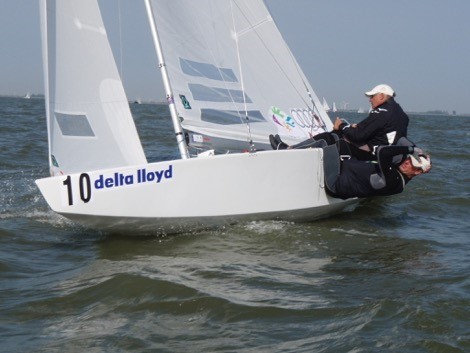

Gear changing is what separates the mid-fleet sailors from those who always seem to be a tad quicker and higher.
While most of the fleet starts the race with a similar setup created with the help of a tuning guide, the fast boats are constantly making additional adjustments. When conditions suddenly change—a puff hits or you sail into a lull, the fast sailors shift gears.
Fix Pointing Problems:
Trying to pinch to maintain height is most likely the reason for your pointing issues and by pinching, the boat is actually sliding to leeward. The remedy is to “foot then point”, a boat needs to go fast so the foils can develop lift, so ease the sails a little bear off a couple of degrees to get up to speed then point up and re-trim to the optimum setting.
Once the boat starts to slow down, be sure to ease the sails out, regain your speed, then start the process again.
While it may seem natural to let the boat heel more when trying to point, fight the urge, keeping the boat flat will maintain a balanced helm and maximize the efficiency of your underwater foils.
When sail trim is the cause of the problem, it’s usually the main, not the jib. The upper leech of the main provides most of your pointing ability so be sure to trim the main so the upper batten is at least parallel to the boom.
If you need more pointing ability, try trimming the main tighter. You can hook the upper batten as much as 15 degrees to weather for short periods but avoid the temptation to over-trim the jib to help pointing ability.
Fix Footing Problems:
The easiest fix is to ease the sails because more open leeches on both sails will help the boat sail lower and faster in a straight line but this can create a pointing problem.
To correct this, first, check your helm balance because weather helm will hinder the boat’s ability to go fast. Instead of easing sheets try to sail the boat more level if you can’t keep the boat flat, induce more mast bend to flatten the main.
The next step is to ease the traveller until the helm is balanced. Other remedies are to tighten the outhaul, tension the Cunningham/jib halyard to pull the draft forward and open the leeches of both sails.
Gear Shift in a Puff:
When a small puff hits.
1. Ease the main.
2. Steer up to “feather” the boat.
3. Re-trim the main.
Because a puff typically lifts the boat due to a change in the apparent wind speed, you need to ease sheets and head up as it reaches you. Let the boat climb to windward and steer toward the upper end of your groove using the jib luff telltales.
If the puff is particularly severe, more adjustment may be necessary. If you can’t hold the boat down after making the above adjustments and there’s still too much helm, do the following until the helm is balanced.
1. Ease the traveller
2. Bend the mast (vang tension, backstay tension, etc.)
3. Tension the Cunningham on both main and jib.
Gear Shift in a Lull:
Lulls usually appear as headers and in a lull, it’s important that you bear off as smoothly as possible. Make sure the boat remains flat and resist the temptation to add heel to maintain “feel” in the helm.
Ease the main so the top batten angles outboard from parallel to the boom, leave the jib trimmed initially until the bow is pulled down to the lower end of your groove with both telltales streaming aft.
At that point, the jib should be eased so the leeward telltale doesn’t stall.
To maintain boatspeed in a lull
1. Ease the main.
2. Allow the boat to heel to weather, creating lee helm, to steer the boat down.
3. Ease the jib.
4. Level the boat.
5. Pull the traveller up (if the boom is below centerline).
If a lull lasts for a longer time
1. Straighten the mast and induce luff sag in the jib
2. Ease main and jib cunningham to maintain correct draft position

